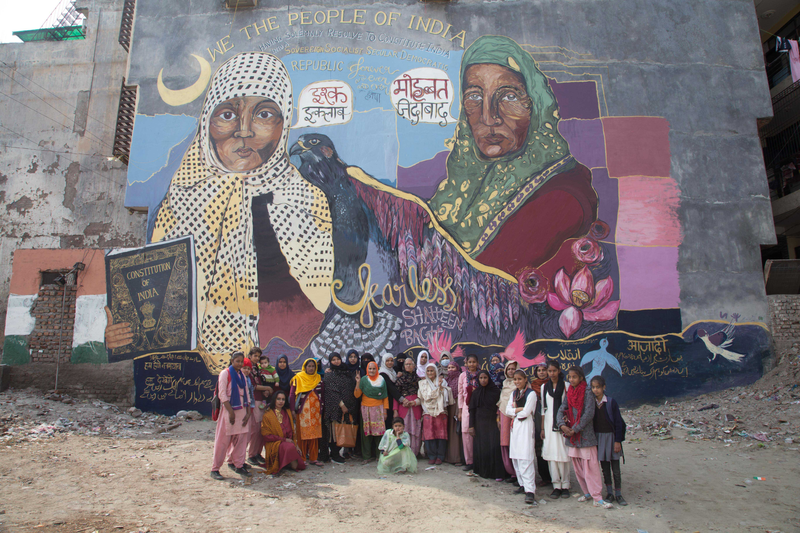The years of the great virus have been a time which the elders of my father’s village would call the breaking of the dam after a night of heavy rainfall.
The first phase of this catastrophe began when Narendra Modi’s Hindu nationalist government came to power for a second time. Soon, his party began fulfilling every promise made in its election manifesto. In August 2019, the region of Kashmir was stripped of the little autonomy it had. Later that year, a discriminatory Citizenship Amendment Bill (CAB) was passed in the Indian parliament, which, together with a National Register of Citizens (NRC), threatened to render millions from the marginalized communities stateless. The protests that broke out all over the country were met by brutal police violence, arbitrary arrests, and Nazi-inspired propaganda. As spring approached in 2020, a pogrom unleashed against the Muslims in New Delhi killed 53 people.
What came next was the noble coronavirus.
On Thursday, March 19, the Indian Prime Minister delivered his first national address. Amidst the COVID-19 pandemic, elegantly eschewing any talk of the government’s mitigation strategy, he asked the people of the country to applaud healthcare workers from their balconies for five minutes on the following Sunday. As expected, his supporters – mostly wealthy, middle-class and upper-caste voters, privileged enough to have a balcony in a nation where two-thirds of the population live in poverty – followed his advice and, to the beat of drums and utensils, chanted “go corona go” for a period far exceeding the suggested time. At the appointed hour that day, as my social media feed flooded with videos of people ringing bells, blowing conch shells, and banging pots and pans, the Muslim ghetto where I live plunged into a deep and defiant silence.
In December last year, Modi’s far-right Bharatiya Janata Party (BJP) government had successfully dismantled the Indian Constitution to give a “legal” makeover to its Hindu nationalist agenda of rendering millions of Muslims stateless. The lethal and discriminatory Citizenship Amendment Act (CAA), together with its associated proposal of a National Register of Citizens (NRC), triggered widespread protests across the country, the epicenter of which was a region of the capital city of New Delhi, loosely referred to as Jamia Nagar after the nearby public university, Jamia Millia Islamia – home to me and more than a million other Muslims.

The Fearless Collective (Gayatri Ganju), courtesy OpenDemocracy.net
During the latter half of March, when the novel coronavirus was forcing the world indoors and when Modi was dramatically asking Indians to observe a one-day people’s curfew, the residents of Jamia Nagar were watching the unfolding events with doubt and apprehension. Sit-in protests led by the women of Shaheen Bagh, a neighborhood in the ghetto, against the contentious laws. The December 15 police attack on the students of Jamia Millia Islamia, inspired similar protests in other parts of the country, despite intimidation by Hindu supremacist terrorists. When vilification by ministers and their supporters in the news media failed to hold back the protesters, a local politician with the ruling party – which had just lost an election in Delhi – helped foment a pogrom in the northeastern areas of the capital city in which 53 people, two-thirds of them Muslims, were killed. When mobs chanting ‘Hail Lord Ram’ were assaulting Muslims on the streets and vandalizing their homes and businesses, Modi – who, ironically, calls himself ‘India’s watchman’ – was serving the visiting United States President, Donald Trump, a much-touted “beef-free” meal. The results expected from the massacre were visible, but not complete; although their numbers had reduced considerably since the pogrom, women still showed up on the streets with posters demanding the abrogation of CAA and NRC. But then, in less than a month’s time, COVID-19 cases began to surge in the subcontinent, and the protesters had to contend with demonstrating symbolically by leaving their slippers at the protest site.
Conspiracy theories blaming Muslims for the spread of coronavirus began when several people who had attended a large gathering in New Delhi of Tablighi Jamaat, a Muslim missionary movement, tested positive. Soon, the Indian government created a separate column of Tablighi Jamaat-related cases in its daily briefings. One newspaper, often hailed for its ‘respectability’, published a cartoon of the coronavirus personified, dressed in a Muslim outfit. The #CoronaJihad hashtag went viral on social media platforms like Twitter. In less than a week, ‘the virus’ became the ‘Muslim virus’.
In The Origins of Totalitarianism, her groundbreaking work on the rise of the Nazi and Soviet regimes, Hannah Arendt wrote how antisemitic canards about a ‘Jewish world conspiracy’ served the ‘most efficient function of Nazi propaganda’. Today, in a country which is steadily growing authoritarian in character, the presence of a similar pattern is ominous and worrying. Even before the rise of Hindu nationalists as a dominant political force in India, Muslims were accused of practicing ‘love-jihad’, a supposed conspiracy among Muslim men to woo Hindu girls and forcibly convert them to Islam. The coming to power of the BJP in 2014 exacerbated the attacks on Muslims, which have worsened to the point where Muslims, from being labeled as seducers, manipulators and tyrants are now the target of epithets that declare them subhuman – pests, termites, and viruses.
The constant dehumanization of Muslims has benefited the peddlers of Hindutva ideology very well. In a country where Muslims are scared to utter the word ‘beef’ aloud on the street, and where cow vigilante violence has become as common as the rising of the sun, this new wave of religious hatred has rendered the use of pretexts like cow-slaughter for the persecution of Muslims unnecessary and obsolete: a beard, a veil, a skull-cap and a name have become the identifying characteristics of a virus, which, by the mere virtue of its abundant and harmful nature, must be and should be gotten rid of. Muslim men and women are being assaulted by violent mobs wielding rods and sticks; in some areas, calls to boycott Muslim businesses are delivered through loudspeakers, while in others, barricades are erected to keep the ‘traitors’ away. Doctors are breaking their professional oaths by refusing to admit Muslim patients. And all this when millions of migrant workers are battling hunger and destitution on their long and arduous walk home from the cities, where there is no longer any employment.
To read the full article see here.



